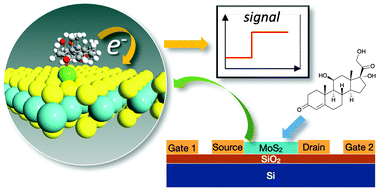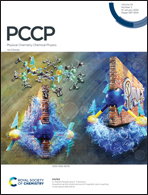Assessing doping strategies for monolayer MoS2 towards non-enzymatic detection of cortisol: a first-principles study†
Abstract
In this work, we investigate by means of atomistic density functional theory simulations the interaction between cortisol (the target molecule) and monolayer MoS2 (the substrate). The aim is to assess viable strategies for the non-enzymatic chemical sensing of cortisol. Metal doping of the sensing material could offer a way to improve the device response upon analyte adsorption, and could also enable novel and alternative detection mechanisms. For such reasons, we explore metal doping of MoS2 with Ni, Pd, and Pt, as these are metal elements commonly used in experiments. Then, we study the material response from the structural, electronic, and charge-transfer points of view. Based on our results, we propose two possible sensing mechanisms and device architectures: (i) a field-effect transistor, and (ii) an electrochemical sensor. In the former, Ni-doped MoS2 would act as the FET channel, and the sensing mechanism involves the variation of the surface electrostatic charge upon the adsorption of cortisol. In the latter, MoS2 decorated with Pt nanoparticles could act as the working electrode, and the sensing mechanism would involve the reduction of cortisol. In addition, our findings may suggest the suitability of both doped and metal-doped MoS2 as sensing layers in an optical sensor.



 Please wait while we load your content...
Please wait while we load your content...